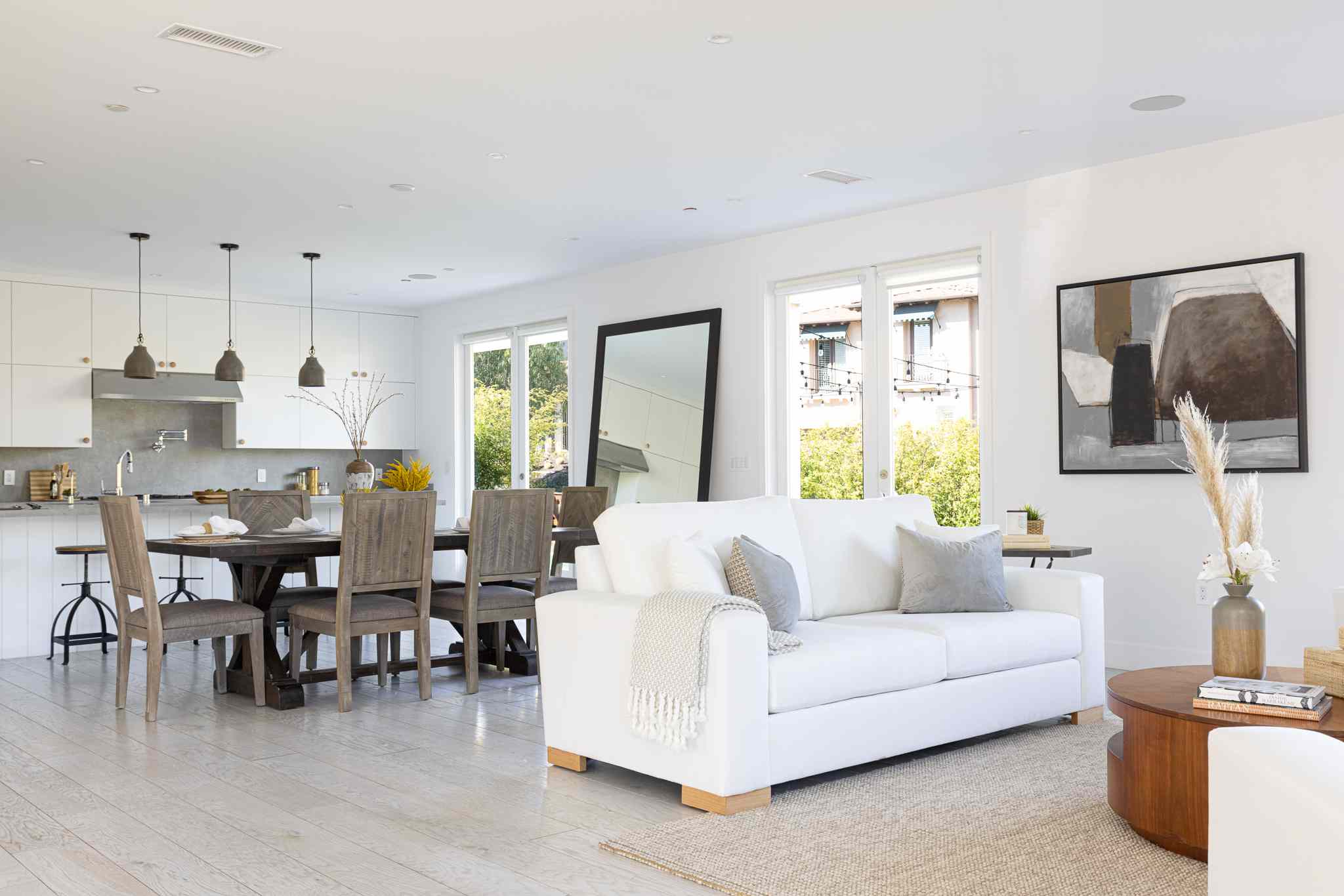Open-concept living, where living rooms and dining rooms become one harmonious space, is a popular trend. This layout creates a sense of spaciousness and flow, perfect for modern lifestyles. However, merging these distinct areas requires careful planning to avoid a cluttered or disjointed feel. This comprehensive guide will equip you with the knowledge and inspiration to design a living room and dining room combo that is both stylish and functional, reflecting your unique taste and maximizing your space’s potential.
Planning Your Space: The Art of Open-Concept Flow
Before diving into furniture arrangements and color palettes, take a step back and evaluate your lifestyle and needs. Consider:
- Functionality: How do you envision using this combined space? Will it be primarily for casual family dinners or frequent entertaining with larger groups?
- Traffic Flow: Analyze the natural pathways through the room. Ensure ample space for movement between the living and dining areas, avoiding furniture obstacles.
- Focal Points: Identify existing focal points, such as a fireplace or a large window, and consider how these can be incorporated into the overall design.
[https://www.wavesold.com/living-room-colors-with-brown-couch]: For an elegant design, try living room colors with brown couch.
Furniture: The Building Blocks of Your Design
The right furniture choices can effortlessly define zones within your open-concept space while enhancing its functionality and style.
- Define the Zones: Strategically place your sofa to act as a natural divider. Position it perpendicular to a wall, facing the living area, to create a visual separation from the dining space.
- Embrace Multifunctionality: In smaller spaces, dual-purpose furniture is your best friend. Think storage ottomans for extra seating and hidden storage, extendable dining tables for flexible entertaining, and convertible sofa beds for overnight guests.
- Scale and Proportion: Consider the size of furniture pieces in relation to the room’s dimensions. Opt for appropriately scaled furniture to avoid overwhelming the space.
Design & Aesthetics: Creating a Cohesive Look
A cohesive design is key to a successful living room and dining room combo. This doesn’t mean everything needs to match perfectly, but rather complement and flow together.
- Color Palette: A unified color scheme is crucial. This doesn’t mean using the same color throughout, but rather selecting hues that harmonize. For example, if your living room features warm, earthy tones, consider incorporating those colors in a lighter shade or with a different pattern in the dining area.
- Materials & Textures: Introduce visual connections through shared materials and textures. If you have a rustic wooden coffee table in the living room, consider dining chairs with similar wood tones. Mixing textures, such as incorporating plush velvet cushions alongside a sleek leather sofa, adds depth and visual interest.
- Statement Lighting: Lighting plays a transformative role. A statement chandelier above the dining table can define the space and add a touch of elegance. Complement this with softer, ambient lighting in the living area, like table lamps or wall sconces, to create a cozy atmosphere.
Those Extra Touches: Infusing Personality
With the foundational elements in place, it’s time to infuse your personality and create a space that feels uniquely yours.
- Natural Light: Maximize natural light by keeping window treatments minimal. Opt for sheer curtains or blinds that allow light to filter through while still offering privacy.
- Accessorize with Intention: Artworks, throw pillows, blankets, and plants are your secret weapons for adding warmth and personality. Don’t be afraid to mix and match textures, colors, and patterns, but ensure they complement the overall design aesthetic.
- Conversation-Friendly Layout: Arrange furniture to encourage conversation and interaction between the living and dining areas. Consider a “U” shape or an “L” shape for the living room furniture, facing the dining table.
Case Studies: Inspiration Awaits!
Need a dose of visual inspiration? Explore online resources and interior design magazines for examples of stunning living room and dining room combos. Pay attention to how designers utilize furniture placement, color palettes, and décor elements to create cohesive and stylish spaces.
Addressing Common Design Dilemmas
Let’s tackle some frequently asked questions about designing a living room and dining room combo:
Q: What exactly IS a combined living and dining room?
A: It’s a single, open space that seamlessly blends the functions of a living room and a dining room, often found in smaller homes or apartments to maximize space and create a more fluid living environment.
Q: How do I make it look good?
A: The key is threefold:
- Define Zones: Use furniture, rugs, or even subtle changes in flooring to create distinct “rooms” within the open space.
- Create Cohesion: Use a consistent color palette and complementary furniture styles to tie the areas together visually.
- Maximize Functionality: Choose furniture that serves dual purposes, like a storage ottoman or an extendable dining table, and consider traffic flow when arranging furniture.
Should living room and dining room match?
Many wonder if their living and dining areas need to perfectly match. While a unified look can be visually appealing, it’s not the only approach.
Matching: Opting for nearly identical furniture styles, colors, and materials in both areas can indeed create a sleek and elegant feel. However, it can also feel a bit too formal or even dated if not carefully executed.
Complementing: This approach provides more flexibility and allows your personality to shine through. Select furniture and décor in different styles, but ensure they share common elements, such as a similar wood tone, upholstery fabric, or design aesthetic.
Tips for Cohesion:
- Color Palette: Use a consistent color scheme throughout, incorporating pops of accent colors in both areas to tie the spaces together visually.
- Shared Design Elements: If mixing furniture styles, look for pieces that share common design elements, like shape, materials, or even a shared historical reference.
- Flooring: The same flooring throughout creates the illusion of a larger, more unified space. If working with different flooring types, choose options that complement each other in terms of color and style.
- Strategic Lighting: Different lighting types can define zones and enhance functionality. For example, a statement pendant light over the dining table creates a focal point while subtle recessed lighting in the living room provides overall illumination.
- Accessories and Décor: Use throw pillows, rugs, artwork, and other decorative elements to introduce pops of color, texture, and personality.
Remember, there’s no one-size-fits-all answer. The best approach depends on your personal style and the overall aesthetic you’re aiming to achieve.
How to Divide a Living Room and Dining Room Combo?
Dividing your living and dining areas doesn’t require building walls. Here are some clever strategies to create separation and define zones:
- Furniture as Dividers: A large sofa, a console table, or even a strategically placed bookshelf can act as a physical and visual barrier between the spaces.
- Area Rugs: Use rugs to define individual “zones” within the open floor plan. A rug placed under the dining table visually anchors the space while a different rug in the living area creates a distinct seating area.
- Lighting Magic: Different lighting types can instantly change the mood and feel of each area. Opt for warm and inviting lighting in the living room and brighter, task-oriented lighting over the dining area.
- Paint and Wallpaper: Create a subtle division with paint or wallpaper. Painting one wall in the dining area a different color or adding a wallpaper accent wall can visually separate the space.
## Designing a Living Room Dining Room: Key Considerations
Merging your living and dining rooms into one cohesive space requires a thoughtful approach. Here are some key takeaways to guide your design journey:
– Cohesive Flow: Utilize furniture placement, lighting, and rugs to subtly divide the areas while maintaining an open and connected feel.
– Design Harmony: Create a sense of visual unity by maintaining a consistent color palette, using similar materials, and selecting furniture styles that complement each other.
– Maximize Space: In smaller combos, embrace multifunctional furniture, vertical storage solutions, and prioritize easy traffic flow to avoid a cramped feel.
– Elevated Design: Enhance the ambiance with layered lighting, incorporate a statement light fixture over the dining table, and add layers of texture and personality through textiles and carefully curated décor.
Remember, your living room dining room combo should be a reflection of your unique style and needs. Embrace the design process, experiment with different layouts and ideas, and don’t be afraid to let your personality shine through!
- How to Remove Water Stains from Fabric: A Complete Guide - April 26, 2025
- How to Get Motor Oil Out of Clothes: Proven Methods & Expert Tips - April 26, 2025
- How to Get Deodorant Out of Black Shirts: Easy Stain Removal Guide - April 26, 2025










